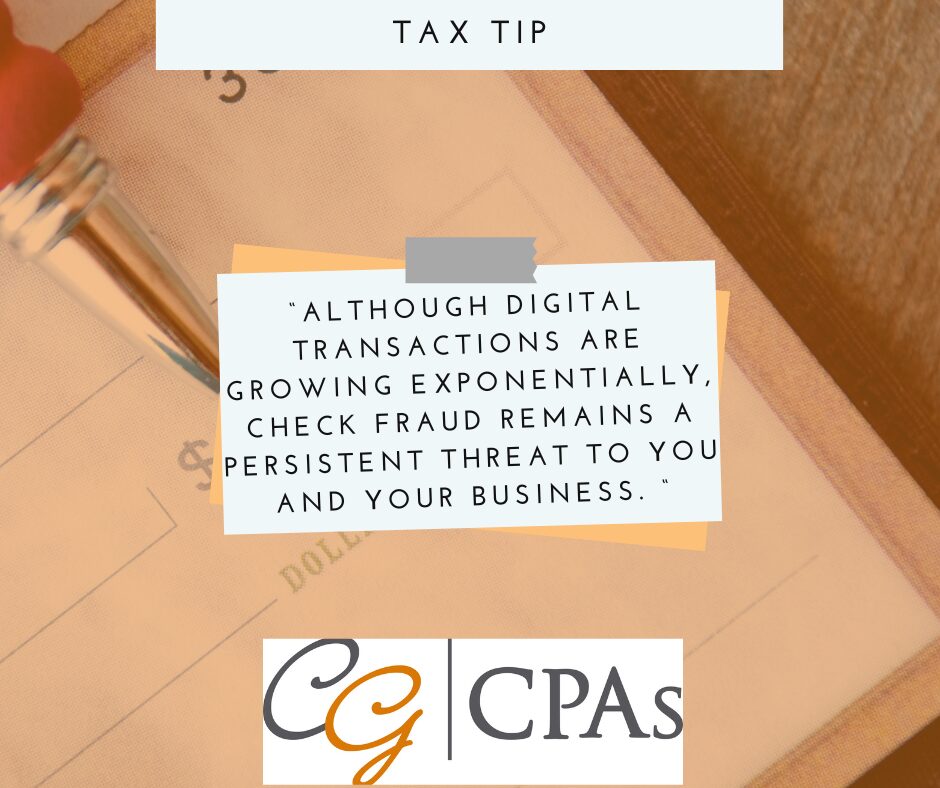Although digital transactions are growing exponentially, check fraud remains a persistent threat to you and your business. The Federal Reserve processed just over 19 billion paper checks in 1993, compared to 3.4 billion in 2022. While fraudsters may target paper checks sent and received by individuals, business checks are likely to be more valuable because business accounts are often well-funded. Plus, businesses may take longer than individuals to detect check fraud.
 Warning from FinCEN The Financial Crimes Enforcement Network (FinCEN), in close collaboration with the United States Postal Inspection Service (USPIS), recently issued an alert to financial institutions about a surge in fraud schemes involving paper checks sent through the mail. Mail theft-related check fraud represents one of the most significant money laundering threats in the United States, according to the U.S. Department of the Treasury. FinCEN’s alert provides an overview of recent check fraud schemes, highlights red flags to help financial institutions identify and report suspicious activity, and reminds financial institutions of their reporting requirements under the Bank Secrecy Act (BSA). BSA reporting for check fraud has increased in recent years. If your business receives a suspicious activity report (SAR) from the bank, respond immediately and take appropriate actions to minimize potential losses. Victims of check fraud schemes should report the incident to the USPIS. |
Today, many businesses continue to send or accept checks, because this method of payment is convenient, widely accepted and doesn’t incur processing fees. However, the chain of mail custody — how checks move through the United States Postal Service (USPS) — provides numerous vulnerabilities for criminals to exploit. From stealing checks from residential and business mailboxes to using counterfeit keys and devices to steal from USPS collection boxes, criminals are highly adept at intercepting paper checks.
Fortify Your Defenses
While check fraud continues to exact a heavy toll on the U.S. economy, you and your business can take proactive measures to combat the threat. Here are six helpful tips:
1. Use inside collection boxes. Criminals may steal or counterfeit the keys used to unlock USPS collection boxes. They also may use devices to “fish” for envelopes and simply take them out of unsecured residential mailboxes. Instead of using collection boxes on sidewalks or leaving mail for carriers to pick up, deposit mail in collection boxes inside local post offices.
2. Make it harder to alter checks. Criminals often “wash” checks to remove the original ink and replace the payee and dollar amount. They then deposit the altered checks into accounts they control. Or they might use another individual’s account (a money mule) to deposit the washed checks. Consider using a pen with ink resistant to check-washing techniques to minimize the risk of altered checks.
3. Learn about your bank’s fraud prevention solutions. Your business should ask your bank to provide an overview of its fraud prevention solutions. For example, check positive pay matches items presented to your bank against checks shown as issued in your check register. Depending on the size of your relationship, some fraud prevention tools may be free; others may be available for a fee.
4. Respond when the bank’s fraud department calls. Financial institutions spend significant time, effort and expense to monitor checks for signs of fraud. A bank employee may call your company to verify whether a check presented to your account is fraudulent. (See “Warning from FinCEN,” at right.)
Important: Before sharing information about your account, confirm the identity of the person who claims to be calling from your bank’s fraud department. If in doubt, disconnect and call your bank directly.
It’s also important for your business to verify that your bank has a current phone number on file and instruct your employees to respond quickly to such calls. Failure to answer a call from your bank’s fraud team can result in fraudulent items being processed. It also encourages criminals to continue targeting your account.
5. Regularly reconcile bank accounts. You can’t rely on your bank’s fraud department to detect every fraudulent check. Reconciling your bank accounts frequently can make it easier to detect and prevent any form of bank fraud, including checks, automated clearing house (ACH) payments and wires.
6. Switch to electronic payments. An ACH is a bank-to-bank transfer that’s quicker and generally more secure than use of paper checks. However, ACH transactions can still result in fraud. Personal accounts must report suspicious ACH payments to their bank’s fraud departments within 60 days to avoid liability, while business accounts need to do so within 24 hours.
For More Information
Many businesses and individuals continue to use paper checks in their daily operations. While convenient, checks offer criminals a relatively easy way of engaging in financial crime. Contact your financial advisor to discuss weak spots in your business payment processes and brainstorm ways to mitigate your risks.

